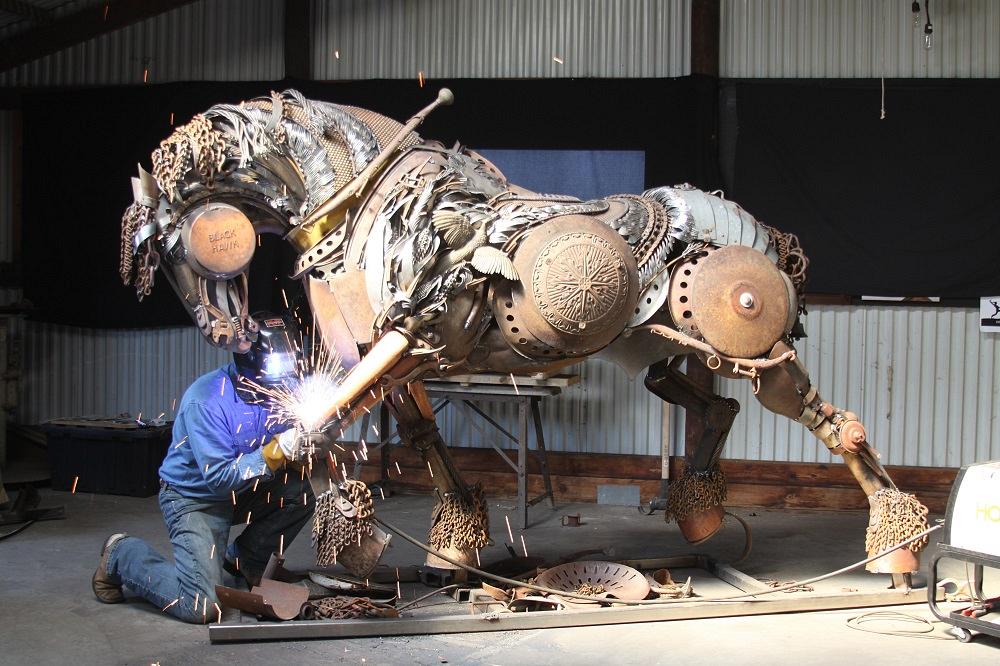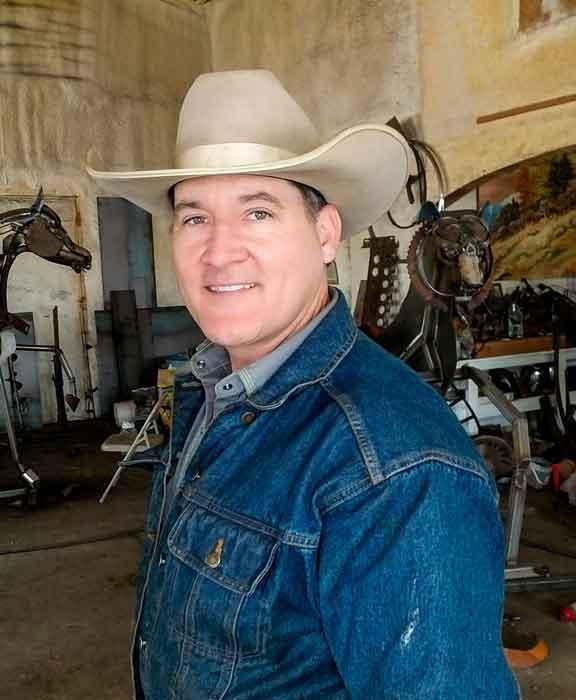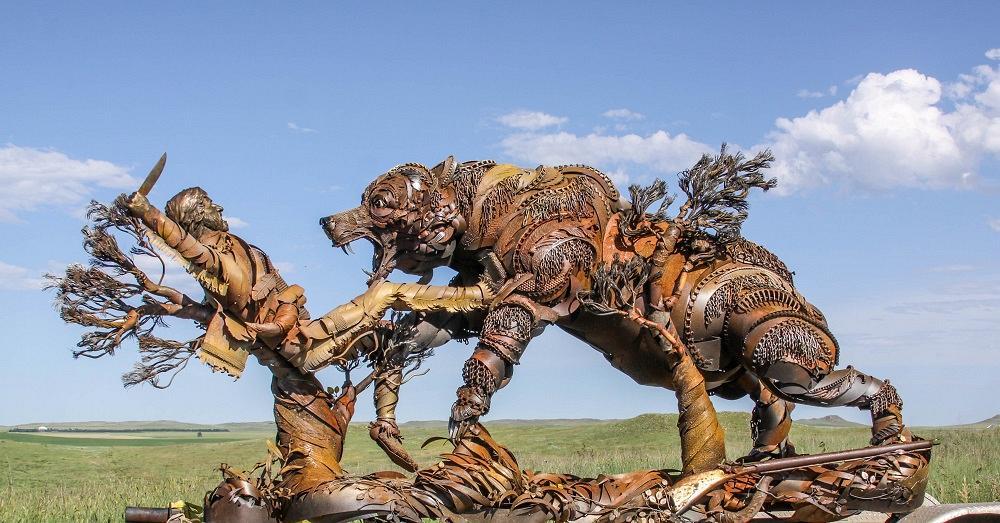- FMA
- The Fabricator
- FABTECH
- Canadian Metalworking
Categories
- Additive Manufacturing
- Aluminum Welding
- Arc Welding
- Assembly and Joining
- Automation and Robotics
- Bending and Forming
- Consumables
- Cutting and Weld Prep
- Electric Vehicles
- En Español
- Finishing
- Hydroforming
- Laser Cutting
- Laser Welding
- Machining
- Manufacturing Software
- Materials Handling
- Metals/Materials
- Oxyfuel Cutting
- Plasma Cutting
- Power Tools
- Punching and Other Holemaking
- Roll Forming
- Safety
- Sawing
- Shearing
- Shop Management
- Testing and Measuring
- Tube and Pipe Fabrication
- Tube and Pipe Production
- Waterjet Cutting
Industry Directory
Webcasts
Podcasts
FAB 40
Advertise
Subscribe
Account Login
Search
Cowboys, horses, bison, bears emerge from scrap metal
Life-size metal sculptures from metal artist John Lopez show history of their South Dakota home
- By Sue Roberts
- April 24, 2020
- Article
- Shop Management

South Dakota metal artist John Lopez uses repurposed scrap metal from vehicles and equipment to create lifelike sculptures. Images provided by John Lopez Studios
Fans of Western movies—or Leonardo DiCaprio— spent breathless moments grimacing as his character, Hugh Glass, was mauled by a grizzly in 2015’s movie “The Revenant.” Based on historical events that took place in the Lemmon, S.D., area, the film is a semi-autobiographical story of the 1823 attack and Glass’ survival.
Attendees entering Lemmon’s Palace Theatre for a special prescreening of the movie were greeted by a life-size sculpture portraying the conflict. John Lopez, Lemmon’s resident sculptor, crafted the depiction of Glass and the bear from metal parts pulled from discarded farm equipment. Today that sculpture is part of the permanent display at Lemmon’s Grand River Museum.
This Glass and grizzly sculpture and many others created by Lopez depict the area and its past. Subjects include bison, horses, presidents, and even a fish-riding cowboy that symbolizes the community’s heritage and the rich fishing found in the Missouri River. The sculptor’s media of choice is repurposed metal from vehicles and equipment that once worked for local farmers, cattlemen, and ranchers and carry their own history forward.
“I use snow chains, plow disks, scoop shovels, teeth from mowers, legs from old washing machines—anything made of steel that I can weld. I live in a scrap metal paradise and collect old metal from friends and neighbors who just want to get rid of it. It’s a win-win,” Lopez said.
Lopez welds the wildly diverse metal pieces onto steel frames, positioning each piece so the proportions of the finished sculpture will be correct as it relates to its real-life counterpart. Some works are so detailed that even the underlying muscular structure can be recognized.
Building Skills
Lopez began his art career working with bronze castings. He would sculpt a model out of clay, use the model to make a mold, and then pour liquid bronze into the mold.
“Studying horses and buffalo when working with clay and growing up on a ranch gave me an advantage when I switched to working with found objects about 15 years ago. I was already familiar with the physical proportions and had the measurements right because I had become familiar with the anatomy. Those details make the sculptures look real,” he said.
Growing up on a ranch also helped develop MIG welding skills that were fine-tuned in a high school welding class and while working with other artists who choose metal as their media.
Lopez’ lifelike sculptures take shape in a studio located on his 14-acre ranch about three miles outside of Lemmon. His preference is to work from his own imagination and build to please himself, but he also builds commissioned pieces.
A larger-than-life sculpture of Ed Lemmon astride his horse was commissioned by Lemmon’s community leaders. The resulting 12- by 8- by 4-foot sculpture resides in Boss Cowman Square next to Lopez’ gallery, Kokomo Inn. A mural of a cattle drive painted on the gallery’s exterior wall provides a fitting backdrop.
Kokomo Inn itself is another example of Lopez’ recycling originality. He turned what was a Main Street bar into the gallery that houses his work.
Sparking Tourism
“People come to Lemmon to see my work in person and to meet me,” he said. “Kokomo gives me a local outlet for my work and a place where people can interact with the art.
“One of the fun parts is watching old-timers walk up to one of my pieces and recognize some of the metal. It starts an interesting conversation. They talk about old machinery they or their grandpas used to have.”
Lopez’s sculptures are seen in exhibits throughout the U.S. and are gaining an international presence. There is one in France, one in Monaco, and several in the Middle East’s Doha, Qatar.
“Right now I’m working on a lot of commissioned pieces, but when I first started, I just did what I wanted to do and people would buy it,” he said. “I enjoy doing both, but I feel a lot more freedom when working just for myself. I get a little more excited about the possibilities as I build and I can take more chances.”
About the Author

subscribe now

The Fabricator is North America's leading magazine for the metal forming and fabricating industry. The magazine delivers the news, technical articles, and case histories that enable fabricators to do their jobs more efficiently. The Fabricator has served the industry since 1970.
start your free subscription- Stay connected from anywhere

Easily access valuable industry resources now with full access to the digital edition of The Fabricator.

Easily access valuable industry resources now with full access to the digital edition of The Welder.

Easily access valuable industry resources now with full access to the digital edition of The Tube and Pipe Journal.
- Podcasting
- Podcast:
- The Fabricator Podcast
- Published:
- 04/16/2024
- Running Time:
- 63:29
In this episode of The Fabricator Podcast, Caleb Chamberlain, co-founder and CEO of OSH Cut, discusses his company’s...
- Trending Articles
AI, machine learning, and the future of metal fabrication

Employee ownership: The best way to ensure engagement

Steel industry reacts to Nucor’s new weekly published HRC price

Dynamic Metal blossoms with each passing year

Metal fabrication management: A guide for new supervisors

- Industry Events
16th Annual Safety Conference
- April 30 - May 1, 2024
- Elgin,
Pipe and Tube Conference
- May 21 - 22, 2024
- Omaha, NE
World-Class Roll Forming Workshop
- June 5 - 6, 2024
- Louisville, KY
Advanced Laser Application Workshop
- June 25 - 27, 2024
- Novi, MI




























